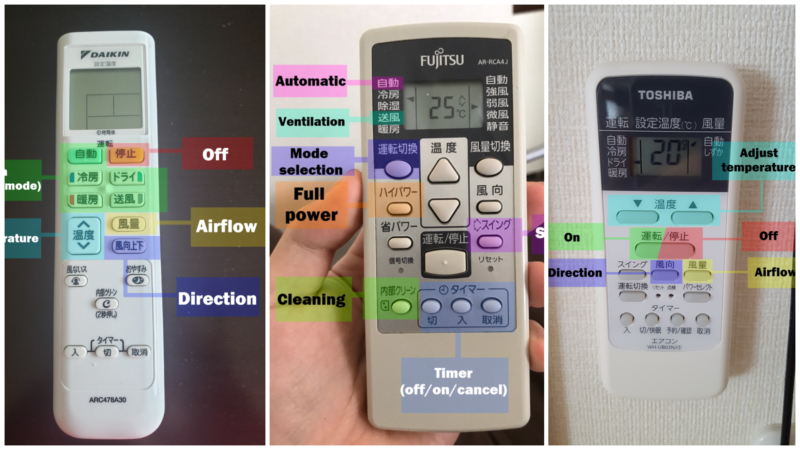Japanese air conditioners. For a task as familiar as warming up or cooling down your house, the language barrier may mean that the act of simply raising the temperature or changing the mode to match the season becomes a struggle. In this article, we’ll go over the buttons you can find on your air conditioner remote and cover the common/uncommon modes your air conditioner can operate in. Along the way, we’ll provide a litany of example remotes and their buttons, annotated for your reference.
Familiar Yet Unfamiliar

Even the hardiest expat living in Japan is usually humbled before the Great Japanese Summer. When the temperature rises and the humidity follows in tow, most everyone retreats indoors and lives under their seasonal friend, the air conditioner.
The trouble is, Japanese air conditioners assume that since you’re living in Japan you can read Japanese. The standard air conditioner in Japan takes the form of a wall-mounted unit controlled with an infrared remote control (usually with a holder mounted on the wall below the unit). These remotes are decorated in a delicious layer of kanji, relying on ancient Chinese pictographs instead of something more accessible for the recently arrived.
Basic Commands on a Japanese Air Conditioner Remote
A Toshiba air conditioner remote
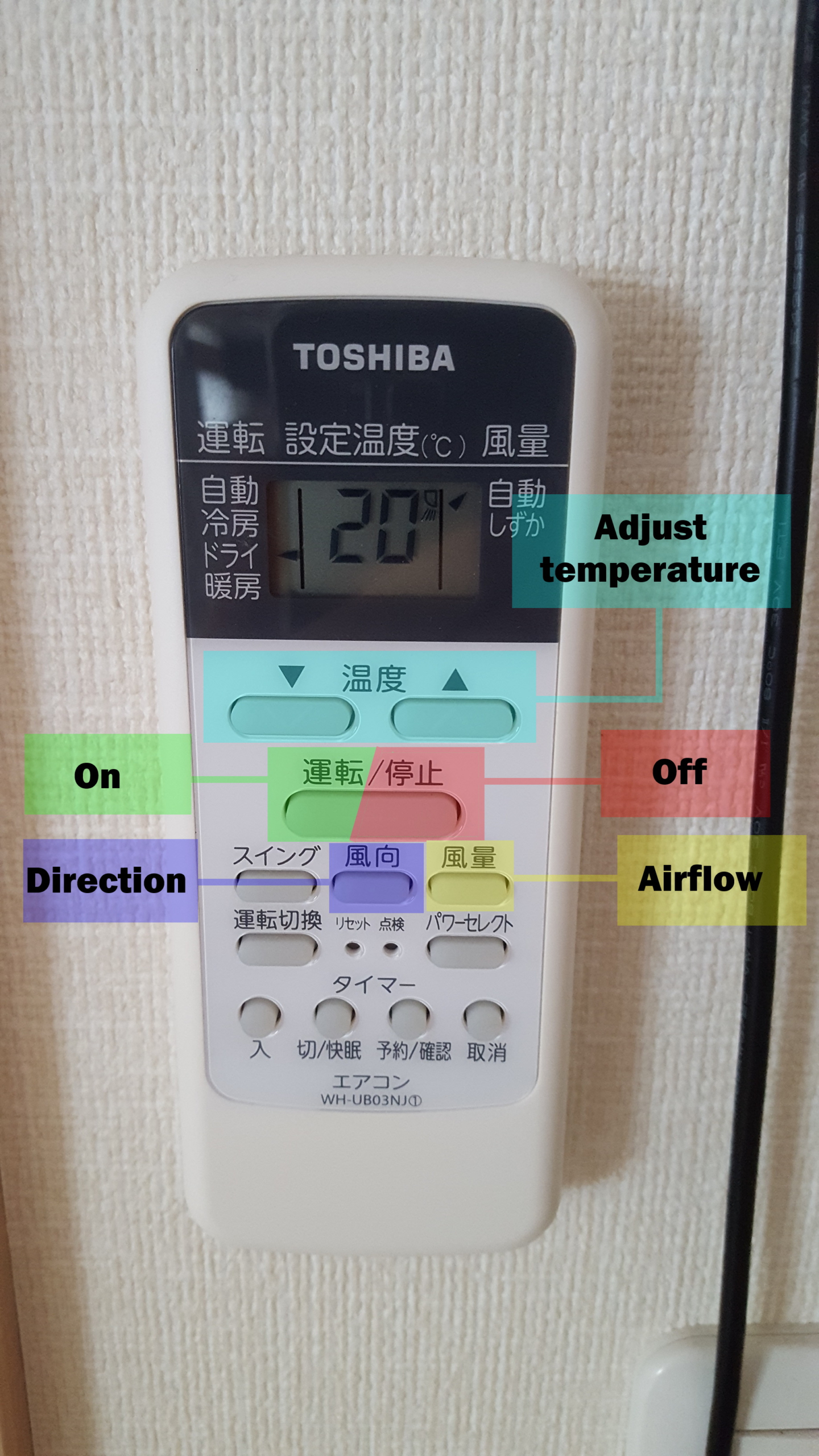
- Turning it on [運転]:
- There are two ways to go about this. On some remotes, there will be a dedicated “on” button that reads 運転 (unten). This button will either be large or differently colored, making it rather obvious. Pressing this button will tell the air conditioner to set itself to the mode you’ve currently selected on the remote screen.
- The second way will be if there is no dedicated on button. In this case, selecting the mode directly (such as heating or cooling) will turn on the unit.
- Turning it off [停止]:
- There will always be a button to turn off the air conditioner. It will be noted with the kanji 停止 (teishi). Sometimes there will be a dedicated standalone button for this, often marked with a raised bar or dot so you can feel for it in the dark. Often though, it will simply be combined with the “on” button, notated as 運転/停止. The first time you press the button will turn on the air conditioner, and the second press will turn it off.
- Rarely, on/off will be noted by the kanji 入/切.
- Adjusting the temperature [温度]:
- The temperature button will be marked with the kanji for temperature, 温度 (ondo). There will be an up and down arrow on the remote to raise and lower the temperature.
- Adjusting the direction of the air [風向] (fuukou):
- Most Japanese air conditioners will allow you to change the direction of the air flow by moving the large flap where the air exits. In most cases, this is just up and down, sending air further back or closer in. On some models though, you can also change the direction left or right. Look for the kanji [左/右] (hidari/migi) which means left/right respectively to see if your model can do this.
- In some cases, up/down will be noted by the kanji [上/下] (ue/shita)
- Adjust the strength of the airflow [風量]:
- Most air conditioners also support the ability to strengthen or weaken the airflow. This will generally be noted by the kanji 風量 (fuuryou) or 風速 (fuusoku). In most cases, clicking this button will cycle through the strength, from low to high. The screen will tell you the strength you’ve selected, either pictorially or with kanji.
- If your model uses kanji instead of pictorial representation, look for these:
- [弱い風] (yowai kaze): weak airflow
- [強い風] (tsuyoi kaze): strong airflow
- [微風] (bifuu): gentle airflow
- [静音] (seion): quiet
A newer Daikin air conditioner remote

The Different Modes of Japanese Air Conditioners
Far from just cooling you off in the summer, Japanese air conditioners can invert the air both ways, which means in summer it will vent warm air out and bring in cool air, while in winter it can vent cool air out and bring in warm air. In general, in terms of changing the temperature of your room, these air conditioners are your most energy-efficient option. These basic modes are found on all Japanese air conditioners.
A Panasonic air conditioner remote
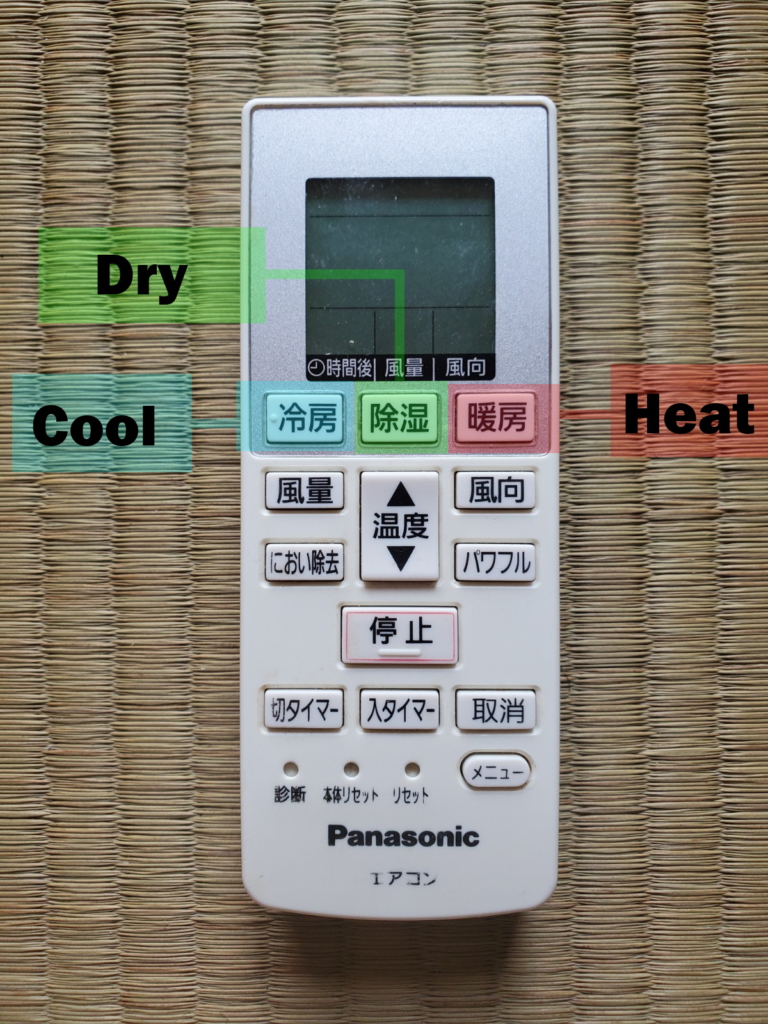
- Heat mode [暖房]:
- This mode will heat up your home or apartment in winter. Look for the kanji 暖房 (danbou), which means heater.
- Cool mode [冷房]:
- This mode will cool down your home or apartment in summer. Look for the kanji 冷房 (reibou), which means cooler.
- Dry mode [除湿 or ドライ]:
- Dry mode is similar to cooling and is used most often in summer. Whereas the cool mode directly converts hot air to cool air, dry instead dehumidifies the air. By taking the moisture out (and dumping it outside), the air will become noticeably cooler for a fraction of the energy cost. As Japan is known for its blistering summer humidity, it serves as an easy and cost-effective way to drop the temperature in your room without brute-forcing cold air in. It will be indicated with either the kanji for dehumidification 除湿 (joshitsu) or the katakana for dry [ドライ].
- Mode selection [運転切換] (unten kirikae):
- If your air conditioner doesn’t have the modes as separate buttons, you will need to change your mode on the screen. Click this button to cycle through the different modes.
A National air conditioner remote
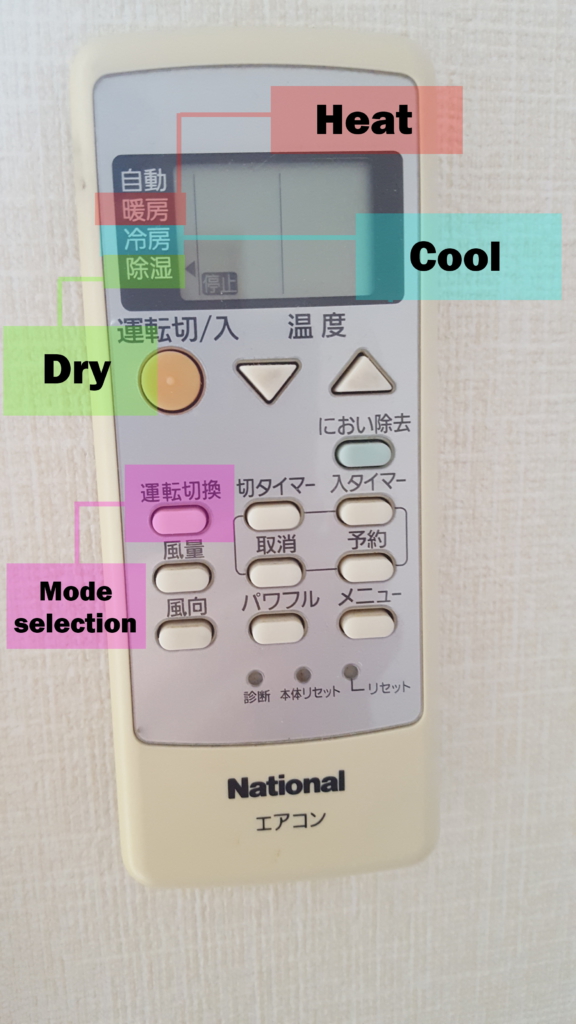
Special Modes on Some Japanese Air Conditioners
The following modes are sometimes built into air conditioners and sometimes not. It depends on the model.
An older Daikin air conditioner remote
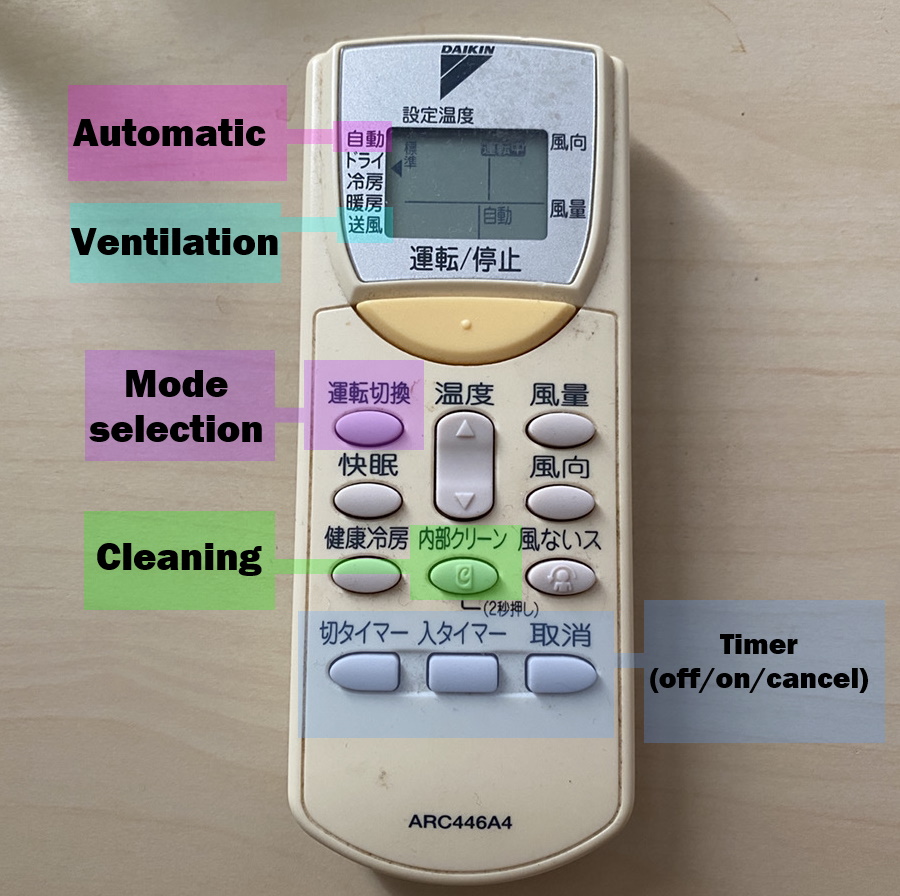
- Automatic mode [自動] (jidou):
- With automatic mode, you set your air conditioner to your desired temperature and the air conditioner will do the rest! This is the fire-and-forget solution to warming or cooling your room.
- Ventilation mode [送風] (soufuu):
- This mode just vents air without treating it. Use it to move air in and out if you find it getting stale.
- Full power mode [パワフル/ハイパワー]:
- The opposite of running the air conditioner in quiet mode, full power will blast the air out as strongly as it can. If you have it, use it to heat or cool a room quickly with no concern for noise or energy efficiency.
- Swing mode [スイング]:
- Instead of having the air direction fixed in one position, swing moves the flap up and down in constant motion, pushing the air evenly across the room.
- Cleaning modes [掃除/クリーン] (souji/clean):
- The air conditioner will go into a quiet mode and clean itself out. Some air conditioners do this automatically when you stop using them.
- On/off timers [入/切 タイマー]:
- If you want your air conditioner to automatically turn on after a certain amount of time, or shut off after a certain amount of time, some remotes come with timers. To set one up, choose whether or not you’re setting a timer to turn on the air conditioner [入] (on), or if you’re setting a timer to turn off the air conditioner [切] (off). Hitting the button multiple times will allow you to cycle through the time options, usually in hour increments. In some cases, after you have configured your desired timer, you need to click [予約] (yoyaku) to input your selection. If you’ve changed your mind, you can also click [取消] (torikeshi) to cancel the timer.
- This function is most useful for turning your air conditioner on/off when you’re sleeping. Turn it on before bed to create a comfortable temperature to fall asleep with a timer that will turn it off while you’re sleeping. Similarly, set an on timer before sleeping so that you can wake up in a comfortable environment.
A Fujitsu air conditioner remote

Purchasing an Air Conditioner
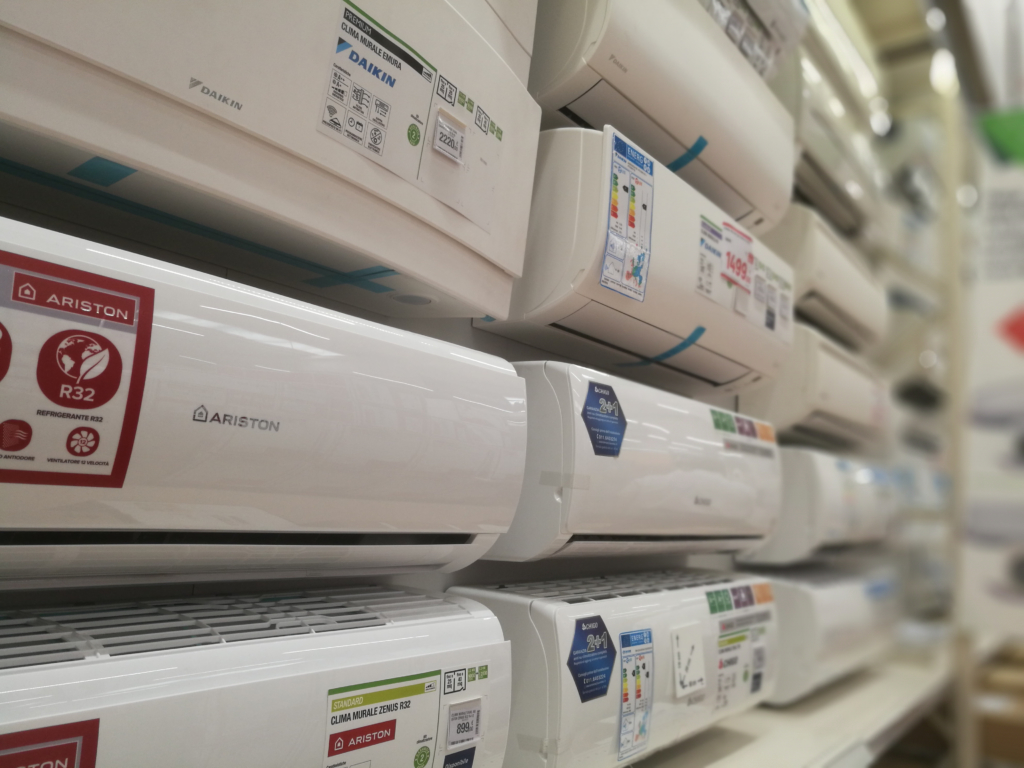
When renting an apartment in Japan, it almost certainly will come with at least one wall-mounted unit. Whether or not the unit will be in the room you want it to be in is less certain. If the air conditioner isn’t working, it’s best to go to your landlord first before trying to do anything to it (besides basic maintenance like cleaning the filter). Similarly, if you want to install a new air conditioner, you need to consult your landlord before making any big changes to your apartment.
Home or property owners, on the other hand, can do as they wish! If you want a new air conditioner, the best place to go will be an electronics store. They will usually have a section (if not a wall) dedicated to the device and its many incarnations. Any big chain such as Bic Camera, Yodobashi Camera, Yamada Denki, or EDION will carry them, and though they might be a bit pricey (as electronics usually are in Japan) you’re guaranteed to get a quality model along with the installation support. Shopping online for big electric appliances in Japan is usually a lot less reliable, and often not even viable as most of the big producers don’t sell their devices online. Searching on Amazon or Rakuten will likely cause more frustration than it is worth, and sometimes be even more expensive than going to one of the big box stores.
Update: You can also save money with coupons for Japanese electronics stores BicCamera, YAMADA DENKI, and EDION.
Expanding Your Air Conditioner’s Abilities: Wifi and Remote Access

Unlike more interconnected systems in other countries, such as the central air control panels that are commonly found in American homes, Japanese air conditioners are stuck using just the infrared remote. If you want to automate your apartment, giving yourself the ability to control your air conditioner when you’re not home or to set routines (such as turning on at a certain temperature threshold or turning off automatically after running for a set number of hours) then you can buy one of many wifi infrared blasters/hubs that exist on the Japanese market.
Products like the LS Mini or Broadlink RM are small devices full of infrared emitters, receivers, and a variety of sensors for temperature and light. They come bundled with an app that you can download to your phone. The app allows you to set up routines or simply control the air conditioner without needing to get up and find the remote. Similarly, as they are infrared controlled, the apps will come with infrared learning software, so even if your air conditioner is extremely old, all you need to do is point the remote at the wifi device and it can decode the button and control it.
With geolocation turned on, the app in combination with the device can do some pretty neat stuff. Set the AC to turn on automatically when you leave work or come within a kilometer of home, making it so that your house is pre-cooled or pre-warmed before you even step foot in the door. Similarly, for those who worry that they may have left the air conditioner on after leaving for work or school, you can do the opposite and have it turned off when you leave the house or just turn it off from the office by pressing the off button. These blasters/hubs never run more than about 5000 yen, and you can easily find them for sale on Amazon.
In the End
Japanese air conditioners are nothing to be afraid of! Although they’re quite presumptions in their expectations of you, most are fairly straightforward to operate and only require the memorization of several kanji. A lot of the extra features that weigh down the remotes will go unused except in very specific circumstances, and you’ll more often than not just leave the settings where they are and turn it on/off when you need it. Just make sure to use it! Heatstroke in the summer and frostbite in the winter are no joke.
As they say (and if they don’t say it, they say it now), the outside temperature in Japan is often the inside temperature in Japan. Take care, and stay comfortable!
If you want to give feedback on any of our articles, you have an idea that you’d really like to see come to life, or you just have a question on Japan, hit us up on our Facebook!
The information in this article is accurate at the time of publication.
